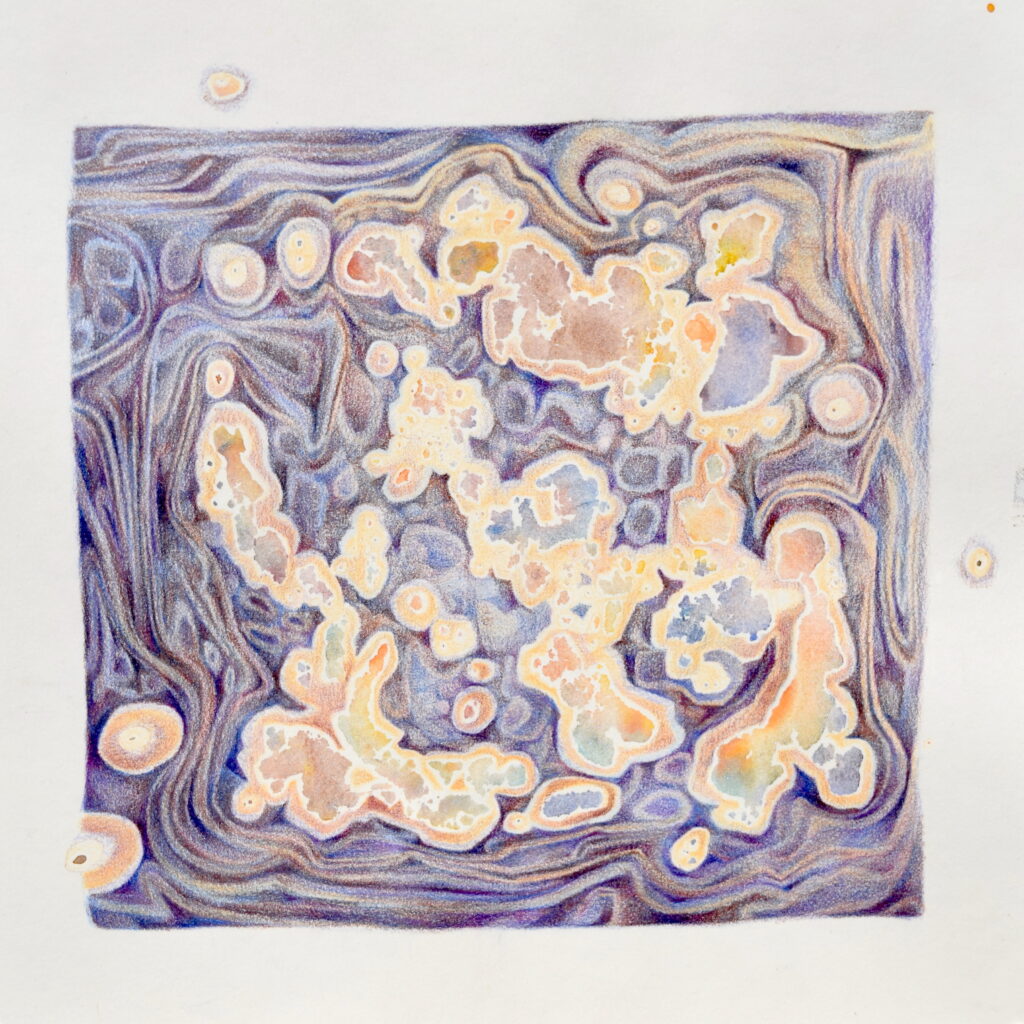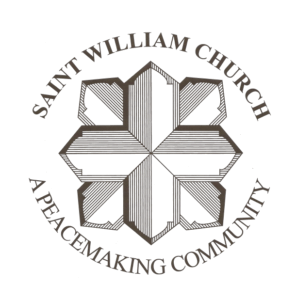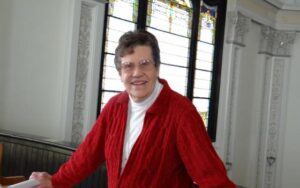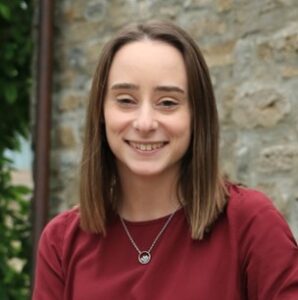A Prayer for Synodality

A Prayer for Synodality, 2022. Advent candle wax, colored pencil, watercolor on translucent paper, mounted on bulletins from a Taizé prayer service.
This work is a prayer for us to experience this time–both the global synod process and this particular Discerning Deacons Listening Session–as Kairos, as the opportune moment to be transformed by encounter with God. I begin each square by drawing a quatrefoil with an Advent candle, a gesture that prepares our hearts to listen. Then lightly with a waxy colored pencil, I write the question I have been pondering in my heart again and again:
how do we make
room for movement
of spirit, the love
that flows between us
I incorporate reflections that surface from listening and participating in synod conversations:
“turn of an epoch,”
“starting with relationships,”
“sitting in the discomfort as repairers of the breach,”
“synodality as a lifelong commitment.”
I sit with these prayerful musings as circles of watercolors–paints that were a gift from my mother, one of the women of Galilee in my own life–pool into one another and dry into unexpected shapes. Shapes untouched by paint let this strong yet delicate paper breathe call my attention; with colored pencil, I carve out these unnameable organic in-between spaces where the Spirit works. I repeat this drawing process with three more squares, and then I arrange the three pieces to make a whole, focusing on the edges that will touch. I listen to the surface of these margins with the tip of my pencil, filling the space with layers of pigment. The joined edges become a river that invites
active currents to meet,
a cross that unifies rather than divides,
an intersection that allows holy, shared insights to congregate.

I mount these paintings on top of bulletins from a Taizé prayer service, grounding myself in the repetitive chants of an ecumenical community that inspires me with its mission of reconciliation.
The paper from the Prayer for Synodality is porous, and watercolor drips down onto the paper underneath, like a print. This residual prayer becomes the foundation of the drawing I create throughout the Discerning Deacons listening session. Through the process of tracing around these initial droplets of color, of drawing in response to my prayer for synodality, I sit with the gathering’s guiding questions: what is the Holy Spirit saying to me about women deacons?
When participants came to see what I was working on, I would show them this drawing eagerly…and also note I was not really sure what was happening yet, just that I had created a space for the Spirit to work through me. My process resonates with the Rilke quote that was a centerpiece on all the tables:
“You must give birth to your images. They are the future waiting to be born. Fear not the strangeness you feel. The future must enter you long before it happens. Just wait for the birth, for the hour of the new clarity.”
-Rainier Maria Rilke
While I made space in my drawing for insight to emerge slowly, table participants held sacred space for the call of the Spirit in their lives around this particular theme of the women’s diaconate. Then they used their creative gifts to give birth to images that embodied the synergies that they were hearing. Many of these images were about the urgency, the opportuneness of this moment as one of transformation, as one to make room for women to honor their call to the diaconate.
The images are telling me that in this time of the synod, the church is in a place of transformation: the Spirit is surfacing with uncontainable energy that we can not suppress. We must listen to this movement and trust the process of emergence, as we reimagine what it means to walk as church. We must honor the call, and speak what we hear surfacing in our souls.
As I gave birth to my images, the deep longing in my heart surfaced yet again, the call to ministry. The deep knowing that my creative practice, both the visual compositions I create, and the words that accompany them, are also ways of making room for the movement of the Spirit, for sharing the presence of God in the world. The pain I feel when the church does not make space for me–or the many other gifted ministers–to fully show up and accompany with their spiritual gifts. From this drawing, I also sense a deep longing to follow in the footsteps of Phoebe and be fully active participants in the liturgy and sacrament.
The drawing witnesses the stories shared by the women of Galilee in our midst. The vow Sr. Joan Mitchell made to preach whenever possible. The awe Rhonda shared at recognizing that her creative writing was actually a gift of breaking open the Word, one she wanted to share in the world. The wonder that Dr. Cynthia Bailey Manns felt watching a woman rabbi preach in her church and the simultaneous pain that her ministry could not include active participation in the liturgy. Naming these stories–and many other beautiful witnesses– in my drawing illuminates the call of the Spirit that this is the opportune moment for the women’s diaconate.
I continue to create paintings in this series of Prayers for Synodality–for gentle, deliberate discernment in our spiritual communities. As the patterns repeat and the cycles evolve, I trust–and hope you will, too–the slow reverberating flow between us and in us and around us, the quiet and all encompassing love of God calling us to give birth to our dreams of a renewed church.
Artist Statement
I think of myself as a creative pilgrim, as one who walks slowly and attentively contemplates movement of the spirit. I respond to these observations by making contemplative maps: ecosystems of emerging forms that offer insight for listening deeply and compassionately to the unfolding questions of life. Cyclical processes of watercolor, colored pencil, ballpoint pen, and pulpy paper illuminate the contemplatively active movement of the inner landscape and its relationship to the physical journeys I walk. The process of drawing helps me discern and untangle how to authentically participate in the interconnected web of life. Ultimately, I seek to live and create in Kairos time as the opportune moment for transformation.
Practices of pilgrimage sustain me as I feel my way through the journey, the process, the mystery. Pilgrimage is both a practice of placemaking and displacing. On one hand, pilgrimage teaches me to engage in the breadth of the community I am a part of with a sense of wonder and openness to new insights. On the other hand, attentiveness to displacement has helped me develop a trauma-informed approach for tending to the wounds, fragility and embodiment of suffering I encounter along the journey. I sink into the layers of story in a place, and at the same time, I recognize the need to walk gently.
Walking the Camino de Santiago, and visiting sacred sites and studying food sustainability in Italy, and repeatedly plein air painting at the James River are just some of the pilgrimage practices that have expanded my understanding of church and the sacraments of baptism, reconciliation, and communion that have shaped me. My experiences in ecumenical and multifaith communities such as have opened art as a spiritual practice, a prayer of reimagining the spiritual community through the process of giving material form to ideas. These pilgrimages build on each other– I am noticing emerging patterns in the visual languages and creative rituals I’ve engaged with along these various journeys, and this resurfacing reminds me that time is cyclical: this pilgrimage of transformation is one of continuous return and renewal.
About the Artist
Casey Murano grew up in Roanoke, Virginia and studied art and geography at the University of Richmond. While in college, her involvement with the Office of the Chaplaincy inspired a series of pilgrimage adventures, including the Camino de Santiago, a semester of visiting traditional Christian sacred sites around Italy, and repeated bike rides to various rivers. These experiences and accompanying reflections culminated in a senior exhibition titled Solidarity: Two Practices of Displacement. She continues engaging with a pilgrim mindset in Minnesota, where she is doing a year of service with the St. Joseph Worker Program and exploring how, especially in the midst of various kinds of displacement, these creative pilgrimage practices support a journey of deep attentiveness to the present moment.
She has exhibited work at the Riverviews Artspace in Lynchburg, VA, as well as in various churches and worship services.
Learn more at www.caseymurano.com







